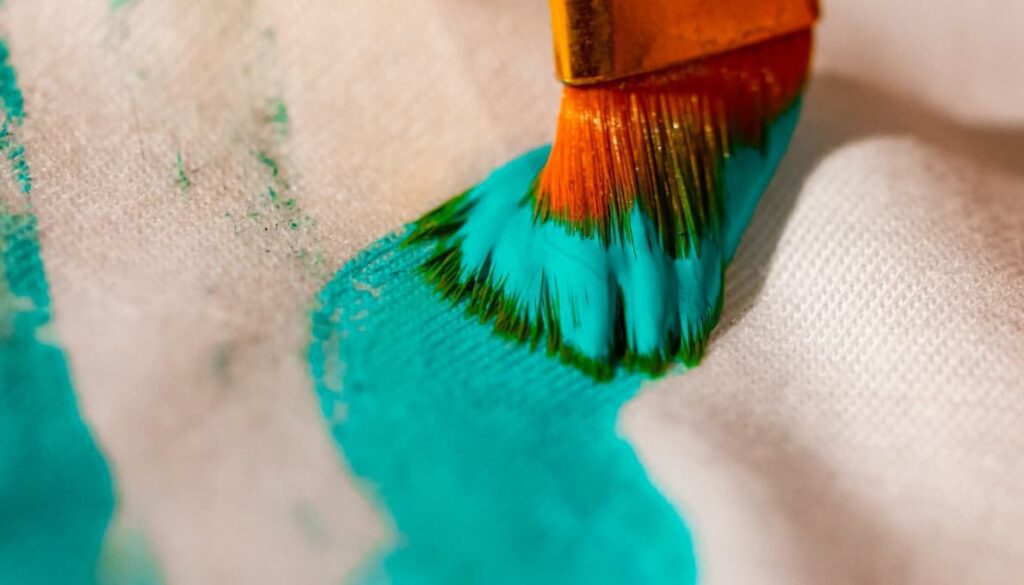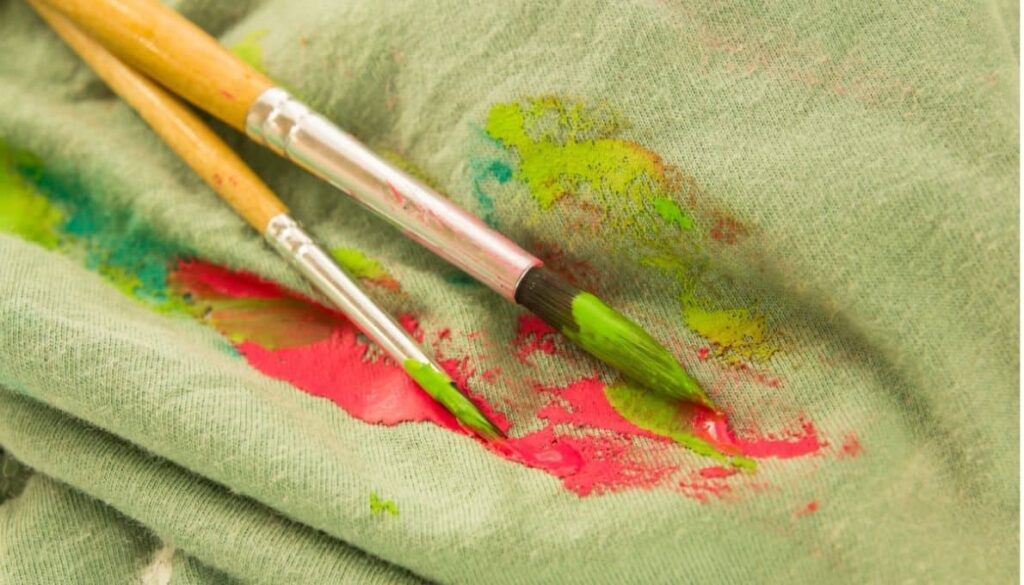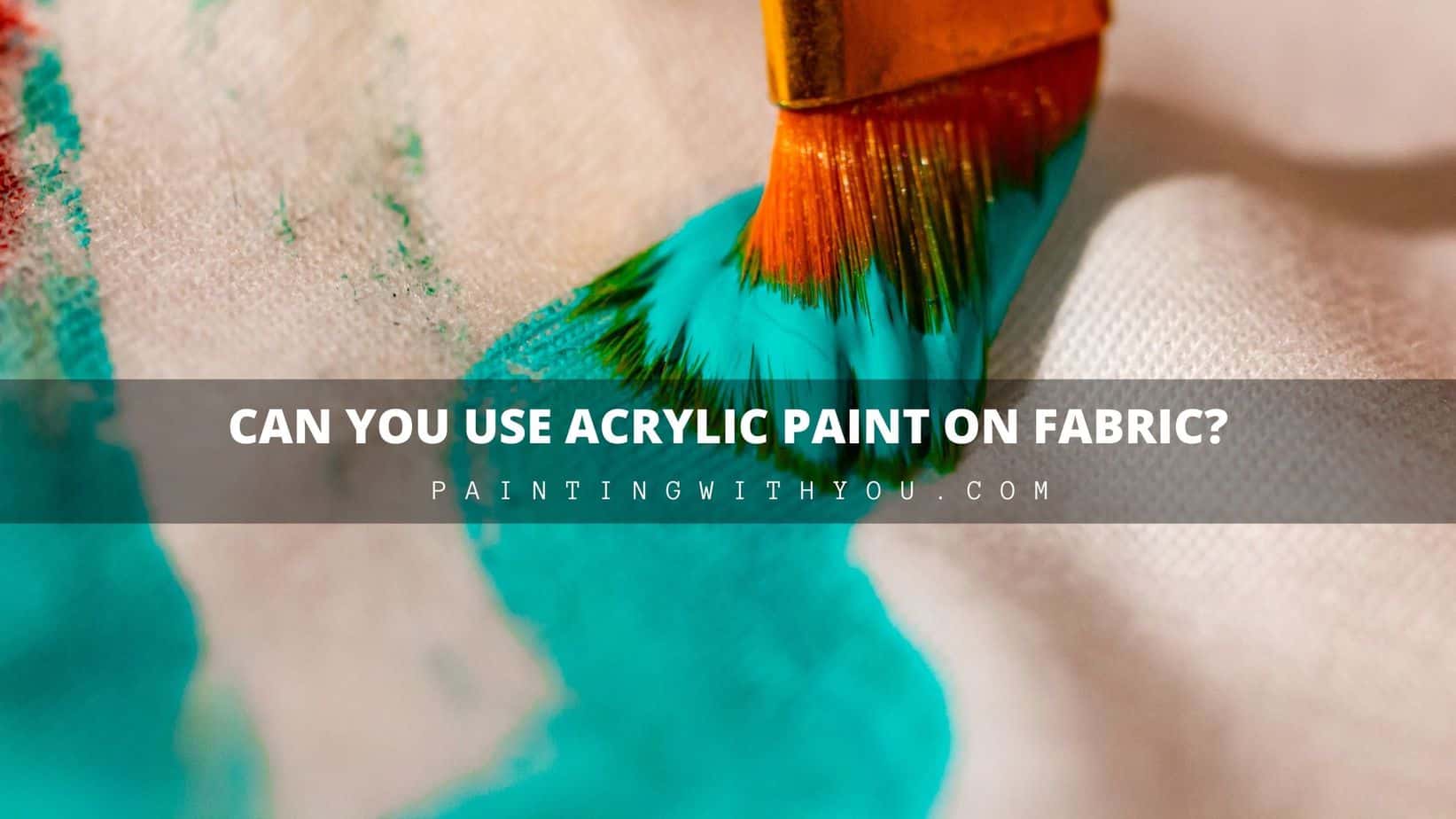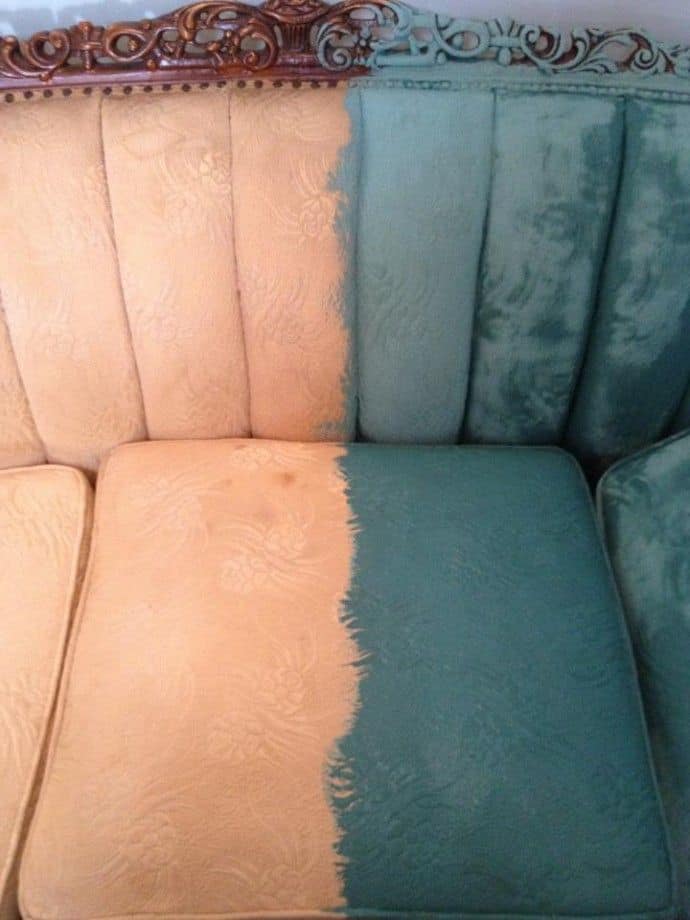Yes! By all means Acrylic paint on fabric does wonders. Pillows, t-shirts, shoes, denim, and furniture are all great projects to put your painting skills to test. With the right type of paint and a couple of learned techniques, acrylics can be a masterpiece on fabrics.
In this article, I’ll cover:
- What works best
- Tips for preparing acrylics for fabric use
- Step-by-step painting techniques
- Heat setting to seal acrylic paint
- Fabric care for washed durability

In short:
You can use Acrylic painting on fabric. It can be done properly when you apply the right amount of paint to a medium. The mixture of acrylic with acrylic medium, allows the fabric to adhere well to the paint. Although acrylics are permanent once dry, you still will have to apply heat to seal your end product.
When most people think of acrylic paints, they think of painting on a canvas. Well, if you think about it – canvas is a fabric. So why not paint on a piece of fabric that can be displayed not only on your walls, but on your furniture, clothes or home accessories. Painting on fabric will give you that added sentiment of individuality.
What fabric works best with acrylic?
Just as in any project you want to start off with a good canvas. The good thing here is that most fabrics work well with acrylic paint. Some examples would be:
Cotton blends (my favorite painting fabric), plain cotton, flannels, silk, wools, leather (another favorite) are all great types of fabrics to use with Acrylics.
A quick search online will show that t-shirts, bags and all types of goods in different fabrics are made with acrylics.
The key to a good acrylic on fabric though is the combination of a good medium with the paint. A lot of times fabric mediums are even added to acrylic paint to help with the smoothness of the lines.
Can i use acrylic paint on clothes?
Yes you can. However, acrylic paint alone will produce a stiff, scratchy finish on clothing that may crack.
Acrylic paint contains polymers that bind to fabric fibers as they dry.
To properly use acrylics on clothes, I recommend:
- Mixing acrylics with fabric medium – The medium maintains flexibility and prevents brittleness. A 2:1 paint to medium ratio is ideal.
- Diluting paints slightly with water – Thinner acrylics mimic fabric paints and bond better than heavy bodied paints.
- Heat setting clothing – Heat fusing the dried acrylic paint to the fabric makes it machine washable without losing the art.
Is acrylic paint permanent on clothes? With proper preparation using fabric medium and heat setting, acrylic paint has excellent adhesion to natural fabrics like cotton and lasts through many washes.
What’s the difference between fabric and acrylic paint?
Fabric paint is defined in the name itself. It is typically used only on fabrics that are natural. such as wool, jute, silk, cotton. The best part is it adheres well to the fabric. Which means that over time and multiple washes, you won’t get any cracking or damage. Bonus point!
Another added bonus is that it is thinner than acrylic paint. This makes the work easy and less stressful for you. When you paint you will notice that the flow of the paint is smooth vs. clumpy. It makes for a soft fabric vs. a rough fabric.
Acrylic paints on the other hand are best to use with synthetic fibers. You can still use them on natural as well, but the technique is different. Acrylic paint is fast drying, permanent and can get rough. You have to mix in a medium to ensure the paint doesn’t stiffen.
Acrylics dry fast so in order to avoid the stiffness you need to mix it with a proper medium to thin it out and adhere. Acrylics can be more work, but you will get a more vibrant piece.
Can You Use Acrylic Paint on Fabric?
Acrylic paint contains pigments suspended in acrylic polymer emulsion. This synthetic binder dries into a plastic-like film. So Yes, Acrylics can be used on fabric, but the paint alone will produce a stiff finish.

Let’s get right into it. As always, we need to get our supplies ready first:
- Paintbrushes – some of the best kinds are in this link.
- Acrylic Paint
- Fabric – cleaned and dried
- Paint Pallet or plastic plate
- Piece of cardboard or plastic sheet
Now let’s start by following this easy steps:
- First let’s get our fabric ready. You will want to wash and dry the fabric to get rid of any grim that might be clinging on.
- Next you will want to get your workspace ready. To be cautious place a piece of cardboard or parchment paper under the fabric where you will be painting. This will ensure the paint does not leak thru to the opposite end.
- Prepare your paint. When using acrylics, it’s best to mix it with a medium such as this brand of Liquitex. It helps the paint bleed less and adhere to the fabric. If you don’t use a medium mixed in with acrylic paints, it will dry very stiff.
- Thin out the paint. Mix the paint with some water. This will help you with the smooth glide of the paint onto the fabric. Resulting in less clump and hardness.
- Using chalk, lightly draw an outline of your image onto the fabric.
- On your paint palette, mixing the medium with the acrylic begin your painting.
- Dry your fabric 100%. Whether it’s in a dryer or hang dried, the paint cannot be wet.
- Apply an iron on fabric mode to permanently press the acrylic into the fabric. Only apply for a short period of time. You don’t want the fabric
Pro Tip: Keep in mind not to push too hard with the paint brushes onto the surface of the fabric. This can cause an uneven paint line, which will make you go over your lines multiple times to get the right line of texture.
How do you seal acrylic paint on fabric?
We seal acrylic paint on fabric with Heat. Applying heat after your painting is dried will ensure the permanency of it. The heat molds the paint into the fabric, allowing for you to wash the fabric and not worry about any cracking.
TIPS: Once paint is dry, place fabric paint-side down on an ironing board. Lay a protective cloth over the painted side. Using a dry iron on medium heat, slowly iron over the fabric for 2-5 minutes to heat seal the paint.
If you do not heat seal your fabric, then here are ideas:
Caring for Acrylic Painted Fabric
It’s important to properly care for painted fabric items to maintain the acrylic artwork:
- Allow paint to cure for 72 hours before washing
- Turn garments inside out before machine washing
- Wash gently in cold water with mild detergent
- Line dry or tumble dry on low heat
- Avoid soaking or spot cleaning painted areas
- Lightly iron inside out on low heat if needed
Properly prepared acrylic paint has excellent adhesion and wash durability on fabric. Maintaining gentleness while washing and drying will keep the painted fabric looking vibrant for many years.
How to soften acrylic paint on fabric
Soft, smooth paint! That is your goal. Because face it, if you are going to be wearing it, you don’t want paint that will pucker up, lump or even worse crack.
You want it to remain flat and smooth. With acrylics, they are intended more for surfaces other than fabrics, it can be done, in a a two-part process. You will need to soften it with a good medium and then apply heat with an iron.
Steps softening Acrylic paint on fabric:
- With the medium place a splotch of it along with the paint on a palette.
- Mix it up a bit to apply. You can use a toothpick if you are extra cautious to mix it up.
- Then let it dry. This could be a long process. 24 hours or more. Don’t rush this part, as you worked hard to get the paint on, so drying is key before you apply the heat.
- Once dried, heat setting comes next. Heat the iron to a fabric setting and apply to the shirt. You don’t want to iron it too long, risking the paint might come off.
Pro Tip: If you are still worried that the paint might come off, iron on the “wrong” side of the shirt with a piece of cardboard under the fabric. This way the paint won’t come off onto the other side of the shirt or the iron!

Does acrylic paint wash off?
Yes and No. What? Let me explain.
Acrylics are water-soluble up until it dries. When it dries, then the paint becomes permanent and you can wash it in the washing machine. The faster you catch the spot of paint that needs to be cleaned or erased the better.
Just washing with soap and water can do the job. Cold temperatures are better so that the heat in the water doesn’t set the paint into the fabric.
NOTE: If for some reason you miss the stain you can still get some tepid water, with soap and dab at it. Do not rub at the spot, it will smear and cause more of a mess.
How to turn acrylic paint into fabric paint without medium?
It’s not recommended to use acrylic paint on fabric without a medium. The fabric becomes rough and uncomfortable. However, if you are in a bind, you can still try and improve the roughness by doing the following:
- Before you start your painting, take a piece of sandpaper and sand down the fabric. Do not by any means rub the fabric so hard that you wear it out.
- Spray the fabric with some water. Don’t make it too damp, but just enough so that it gives you a good fluid flow with the acrylics on the paintbrush.
- Thin out the acrylics with some water so that the paint doesn’t clump or give you uneven strokes.
Can you use acrylic paint on fabric furniture?
You most certainly can! It might be a bit more nerve-wracking, but it can be done. I would definitely mix the acrylics with a fabric medium since we are touching a piece of furniture. Furniture since it is bigger than most other typical fabrics and more expensive will take a lot more time and patience to complete. I find that it will also be tougher since it’s not easy to throw a chair into the washer.
Thoroughly cleaning the piece before applying the paint needs to be done first. You also need to tape of any sections that you want to ensure acrylics don’t touch. Remember acrylics turn permanent fast, so you need to be very cautious when attending a piece of furniture.
As I finish off this piece, and you begin your project, I just want to leave you with one very important Pro Tip: Do not be discouraged with your first piece if it tends to crack or chip off the fabric. As always practice makes perfect!
Yes, but it can crack without certain factors taken into consideration. Acrylics when dry can crack. That surface of the acrylic paint doesn’t like to be stretched either.
That means finding a good quality jean is better than painting on say jeggings. Try to also mix in a fabric medium with the acrylics so that the paint is more resilient and conforms to your painting.
FAQs
Can acrylic paint be used on fabric?
Yes, acrylic paint can be used on fabric when properly prepared with fabric medium to maintain flexibility and heat set to seal the paint. Acrylic adheres well to natural fabrics.
Will acrylic paint stick to fabric?
Acrylic paint will stick to fabric if the right steps are taken – mixing with fabric medium, heat setting, and proper care. Acrylic alone may peel or crack when washed. The medium binds acrylic to fabric for good adhesion.
How do you get acrylic paint to stay on fabric?
To get acrylic paint to stay on fabric, mix it with fabric medium before applying. Heat set the dried paint by ironing for 5 minutes. Wash gently in cold water and tumble dry low. The medium binds the acrylic to the fibers while heat fusing ensures paint adheres.
What can I mix with acrylic paint to make it stay on fabric?
Mix acrylic paint with fabric medium to help it properly adhere to fabric. The medium maintains flexibility and creates a paint film that bonds securely to fabric fibers rather than flaking off.
What kind of paint can you use on fabric?
Acrylic paint mixed with fabric medium works well on fabric. There are also specialty fabric paints designed for use on natural and synthetic fabrics. Some options are Dye-Na-Flow, Tulip Soft Fabric Paint, and Jacquard Textile Color Fabric Paint.


